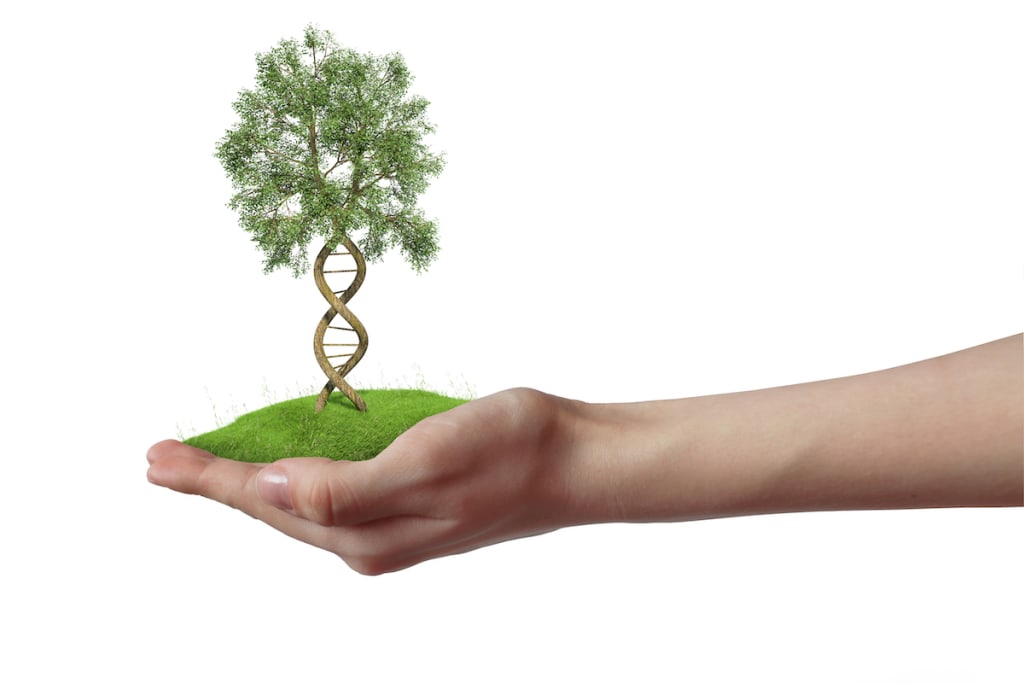ENVIRONMENTAL DNA POSES SCIENTIFIC AND ETHICAL DILEMMAS
Environmental DNA (eDNA) comes from the traces of genetic material organisms shed as they go about their lives. Find out how our ability to analyze human eDNA samples is a mixed blessing for the fields of ecology and forensics.

I remember sitting behind our tall, black science lab benches in our high school biology classroom while Mr. Pollard told us about the relatively new concept of deoxyribonucleic acid (DNA). About all I remember today is the now-iconic double helix shape and the four nucleotides, adenine (A), thymine (T), cytosine (C), and guanine (G) that paired up to form the ladder’s rungs.
We also heard about James Watson and Francis Crick, who had won the Nobel Prize for discovering that molecular structure. We didn’t hear about Rosalind Franklin or Linus Pauling, who paved the way for that discovery, but textbooks tend to simply these things.
Our teacher explained that someday in the distant future, it might be possible to actually map the billions of base pairs of nucleotides making up the human genome. Supercomputers enabled the Human Genome Project to accomplish that about a quarter of a century later.
DNA Analysis Has Become Commonplace
Today, DNA analysis has become commonplace. Courts started admitting DNA evidence about four decades ago.
DNA sequencing has also revolutionized fields like ecology, medical diagnosis, pharmacology and agriculture. In one of the most significant advances in DNA sequencing, scientists can take non-invasive DNA samples from water, soil or air instead of directly from individual organisms.
This technique is called environmental DNA (eDNA). All organisms shed traces of their DNA through skin cells, waste, hair and other tissues.
Organisms Shed Traces of DNA
David Duffy earned his PhD at the National University of Ireland in Galway. He’s an assistant professor of wildlife disease genomics at the University of Florida.
Professor Duffy has had a lifelong interest in genetics and how dysfunction in genetic programs can trigger diseases like cancer. For over a decade, he’s been deciphering the cellular signals behind wildlife and human cancer.
Ecologists like Professor Duffy have enthusiastically adopted eDNA techniques over the past ten years because of their efficiency. They’re a simple and affordable way to monitor species movements in the wild or to detect pathogens in drinking water, for example.
Finding Traces of Human Environmental DNA
While working with a research team to track disease in sea turtles, Professor Duffy found he was finding human environmental DNA wherever he took samples in the wild. This prompted him to think about how eDNA sampling might affect personal privacy and human rights.
The team calls this environmental DNA from people “human genetic bycatch” (HGB), and it’s a contaminant interfering with their work. However, the remarkable quantities of HGB Professor Duffy’s team turned up in their sea turtle studies piqued their curiosity about what someone could find out by abusing their techniques.
The scientists decided to test how much personal information they could extract from traces of human environmental DNA. They took samples from a range of settings, including river banks and building interiors.
Minuscule Traces Contain Individual Medical Data
The researchers published their findings last week in the journal Nature Ecology and Evolution. The results show that even minuscule traces of environmental DNA enable scientists to pull together both medical and genealogical data about individuals.
In one case, the team drew a 350 ml (1.5 cup) water sample from a creek in St. Augustine, Florida. Using a compact, $1,000-dollar gadget called a nanopore sequencer, they surprised even themselves with the volume of human environmental DNA they managed to extract.
The scientists retrieved enough mitochondrial DNA to create a demographic profile of the ethnicity of the community living along the creek. They checked their findings against the area’s census data and found a remarkably close match.
Complete Enough for Missing Persons Database Standards
One sample was complete enough to meet the federal missing persons database standards. Professor Duffy and his team also identified mutations associated with diabetes, heart disease and vision problems.
In one case, they isolated an individual with a mutation that can indicate a potentially fatal, hereditary brain disease. This observation prompted Professor Duffy to ponder if this person or those around them knew about this condition and its implications for their future.
These discoveries pose bioethical and human rights concerns. So far, nobody has given much thought to these issues.
Who “Owns” the Genetic Material We All Shed?
Who “owns” the genetic material we all shed as we go about our daily lives? Could it be used to oppress minority groups the way China already genetically tracks Tibetans and Uyghurs to deny them their rights?
Could law enforcement abuse environmental DNA evidence leading to wrongful convictions? If, like me, readers have watched The Innocence Project on Netflix, they’ll appreciate how pseudoscience can find its way into court rooms and send the wrong people to jail.
Professor Duffy and his team have shown us what a mixed blessing knowledge can be without wisdom to guide its use. Environmental DNA has unveiled a massive body of data on ecology such as species presence, biodiversity and food chain interrelationships.
Not Ready for Prime Time in the World of Forensics
Even so, environmental DNA isn’t ready for prime time in the world of forensics. It doesn’t usually meet the standards of the FBI’s Combined DNA Index System (CODIS), for example.
We wouldn’t want misguided investigators to use eDNA technology indiscriminately. That could repeat past injustices caused by premature use of hair, blood spatter, and bite mark evidence, for example.
We also wouldn’t want to see busybodies collecting environmental DNA samples to find out someone’s medical condition. We don’t have comprehensive eDNA laws and guidelines to prevent any of these abuses yet.
And Another Thing…
We humans tend to get ahead of ourselves. We have a nasty habit of inventing tools and acquiring knowledge before we apply our wisdom to work out the ethical principles governing their use.
Maybe that’s what the Adam and Eve myth with its Tree of Knowledge is all about. The team’s research paper summed up these issues nicely.
“Regulators, researchers, funders and other stakeholders should develop responses to the ethical implications of HGB and intentional human eDNA applications…Conversely, these same eDNA approaches can open up novel beneficial applications in areas from human health to criminal forensics.”
We always have more to learn if we dare to know.
Learn more:
Your DNA Can Now Be Pulled From Thin Air
Grizzly Bear DNA Matches Indigenous Human Languages
About the Creator
David Morton Rintoul
I'm a freelance writer and commercial blogger, offering stories for those who find meaning in stories about our Universe, Nature and Humanity. We always have more to learn if we Dare to Know.






Comments
There are no comments for this story
Be the first to respond and start the conversation.